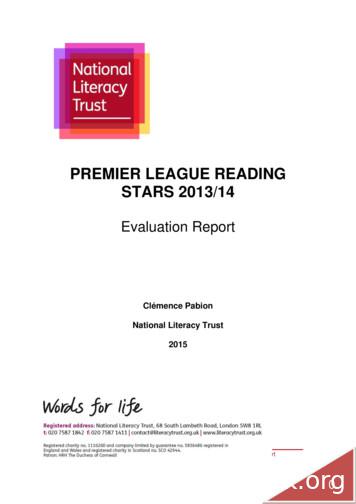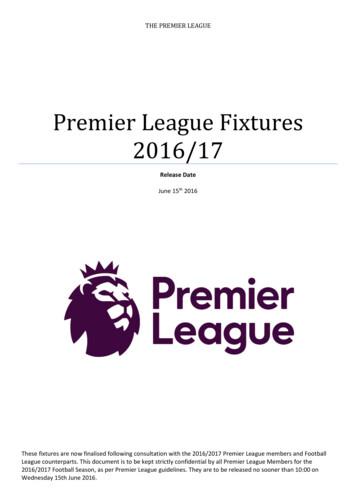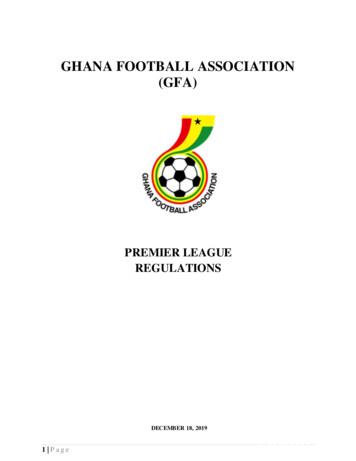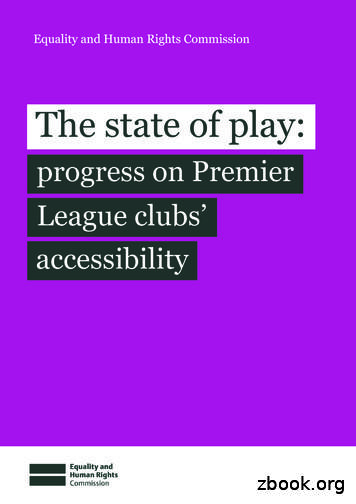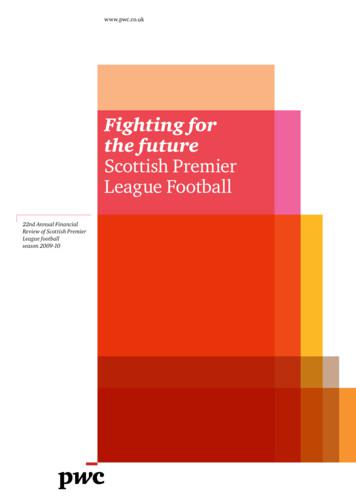PREMIER LEAGUE READING STARS 2013/14
PREMIER LEAGUE READINGSTARS 2013/14Evaluation ReportClémence PabionNational Literacy Trust2015 National Literacy TrustPremier League Reading Stars 2013/14 outcome report0
About the National Literacy TrustWe are a national charity dedicated to raising literacy levels in the UK. Our researchand analysis make us the leading authority on literacy. We run projects in the poorestcommunities, campaign to make literacy a priority for politicians and parents, andsupport schools.Visit www.literacytrust.org.uk to find out more, donate or sign up for a freeemail newsletter. You can also find us on Facebook and follow us on Twitter.Copyright National Literacy Trust 2015. You may report on findings or statistics included inthis report if you accredit them to the National Literacy Trust.Suggested reference for this report is: Pabion, C. (2015). Premier League ReadingStars 2013/14. Evaluation Report. London: National Literacy Trust.We will consider requests to use extracts or data from this publication provided thatyou: Acknowledge that the content is the work of the National Literacy Trust andprovide appropriate references in any publications or accompanying publicity;State that any views expressed are yours and not necessarily those of theNational Literacy Trust. National Literacy TrustPremier League Reading Stars 2013/14 outcome report1
AcknowledgementsWe would like to thank the pupils and staff at the following schools and librarieswithout whom this study would not have been possible:Bowbridge Primary school, Hothfield Junior School, Mansbridge Primary School,Grange Park Junior School, Kingsmoor Academy, Poole High School, Bigyn PrimarySchool, SS John Fisher and Thomas More RC High School, Pudsey Bolton RoydPrimary School, Churchill Gardens Primary Academy, Maybury Primary School, DeBohun Primary School, Mayfield School, Highfield School, Lister Community School,Capel Manor College, Sedgefield Primary School, Holyheads school, The BarclaySchool, Hamworthy Park Junior School, Easterside Academy, Heritage ParkCommunity School, Highfields School, University CE Academy Ellesmere Port, OasisAcademy Parkwood, Bentham Library North Yorkshire County Council, Suffolk NewAcademy, West Earlham Junior School, Wilbraham Primary School, Derby HighSchool, Queensbridge Primary School, King Charles I School, Newham BridgePrimary School, Wimbledon Chase Primary School, Sunnyfields Primary School,Windwhistle Primary School, Sir John Cass's Foundation and Redcoat School,Castor CE Primary School, Cantonian High School, Coppetts Wood Primary School,Harper Green School, Olive Hill Primary School, Heritage High School,, ThomasClarkson Academy, St Gabriel’s RC High School, St. George's RC High School,Norwich Primary Academy, St Thomas More RC Primary School, The NottinghamEmmanuel School, Audley Junior School, All Saints CE Primary School, CaldmoreCommunity Primary School, Oasis Academy Henderson Avenue, Dell PrimarySchool, Sir John Talbot's School, Wheatley Park School, Manford Primary School,Ludlow Junior School, St. Patrick's Primary School, Oasis Academy Lister Park,Francis Askew Primary School, Forest Gate Community School, Marsden HeightsCommunity College. National Literacy TrustPremier League Reading Stars 2013/14 outcome report2
Table of contentsAcknowledgements . 2Tables and figures . 4Executive summary. 5Key findings . 5Introduction . 7Brief background . 7What PLRS does to address these issues . 7Methodology . 9Sample demographics. 9Findings . 10Attainment . 10Reading enjoyment . 10Reading confidence. 11Book choosing skills . 13Attitudes towards reading and writing . 13Reading behaviours . 14Library use . 16Programme fixtures . 17Conclusion . 18Appendix . 19 National Literacy TrustPremier League Reading Stars 2013/14 outcome report3
Tables and figuresTable 1: Average sub-level increase per group . 10Table 2: Reading enjoyment. 11Table 3: Reading enjoyment by primary and secondary schools . 11Table 4: Reading confidence . 12Table 5: Reading confidence by social background . 12Table 6: Reading confidence by primary and secondary schools . 12Table 7: Book choosing skills . 13Figure 1: Attitudes towards reading . 14Table 8: Attitudes towards writing . 14Table 9: Reading frequency . 14Table 10: Reading frequency by primary and secondary school . 15Table 11: Reading behaviours . 15Table 12: Reading behaviours by FSM . 15Table 13: Reading behaviours by primary and secondary schools . 15Table 14: Library use and memberships. 16Table 15: Library use by ethnicity . 16Table 16: PLRS films by primary and secondary school . 17Table 17: PLRS films by FSM . 17 National Literacy TrustPremier League Reading Stars 2013/14 outcome report4
Executive summaryThe National Literacy Trust’s Premier League Reading Stars programme (PLRS) is areading intervention for children aged 8 to 13 that captures the motivational power offootball to inspire children and young people to read more and to improve theirliteracy skills.PLRS is delivered by teachers and librarians. The programme delivers statutoryrequirements of the national curriculum through 10 football-themed literacy sessions.The sessions include activities to help children choose texts that are at the right levelfor them and of interest to them, and teaches them how to skim and scan for relevantinformation. In addition to lesson plans, supporting packs include challenge wallposters, reading journals, promotional posters, wristbands and pencils. Theprogramme is further supported by online resources in which Premier Leaguefootballers talk about what, where and why they like reading.In 2013/14, 888 children participated in our evaluation. Of the children and youngpeople who participated, 74% were boys, 46% were in primary school and 33% wereeligible for free school meals (FSMs). The proportion of children eligible for freeschool meals within PLRS participants is higher than the national average:disadvantaged children tend to have lower literacy than their better-off peers so theyare more likely to be selected by teachers to take part in this motivationalprogramme. The children were aged between nine and 13.Attainment data were available for 812 of the participating children. Approximately70% were boys and 30% were girls, and 29% of the sample were children on freeschool meals. Attainment data were also available for 231 non-participating children.Key findings On average, surveyed children went up 1.3 sub-levels over the course of the10-week programme, which represents approximately six months’ progress.In comparison, children who did not participate in PLRS activities progressedby 0.85 sub-levels in the same period of time. Before taking part in the programme, the majority of children (63%) either didnot like reading at all or only liked reading a bit. After the programme, twiceas many children now enjoy reading either very much or quite a lot (73% vs.35%). Reading enjoyment has particularly improved for primary schoolchildren over the course of the programme: half of them now say they likereading very much (51% compared to 24% before), while the proportion ofchildren in primary schools who do not enjoy reading at all decreased from13% to only 2%. After the programme, four children in five (84%) read confidently comparedwith only half (51%) of the sample before. Boys benefited more in terms ofconfidence than girls: they were slightly less confident than girls before (50%vs. 52%) but are more confident than girls after participating (86% vs. 74%).Asian children are the most confident of all groups after the programme: 65% National Literacy TrustPremier League Reading Stars 2013/14 outcome report5
are very confident about their reading skills, while there was little differencebetween various ethnic groups before the programme. The proportion of children who read every day has doubled by the end ofprogramme, increasing from 16% to 33%. Two children in five (37%) on FSMs, and three in ten (31%) of all surveyedchildren have joined a library because of the programme. Three children inten (36%) say that they use the school library more often now than they didbefore PLRS. About two-thirds of children (66%) feel they are better now at choosing booksthat fit both their interests and their reading skills. This means they are morelikely to read more and to enjoy reading more: 49% of children who are nowbetter at choosing books say that they enjoy reading very much comparedwith 38% of the total sample. The children who took the online challenges aremore likely than their peers to have improved their ability to pick books at theright level that meet their interests (74% are better at choosing books theyenjoy vs. 71% of the total sample). Three children in five (60%) are now proud to be readers. Half (50%) thesurveyed children now think that reading is cool and a third (34%) choose toread in their spare time. Primary school children have notably more positiveattitudes than their older peers: 61% think that reading is cool vs. 38% ofsecondary school pupils. After completing PLRS children on FSMs displayslightly more positive reading attitudes than their peers. For example, 55%think reading is cool as opposed to 48% of their peers. 66% said that watching footballers read made them want to read. They seemto directly link the pleasure of reading with the passion they have for football,and their admiration of footballers. 71% of the participating children watchedthe PLRS films online. Three in four said that the films inspired them to readmore and the same proportion said they wanted to read the footballers’favourite books after watching the films.In conclusion, the PLRS programme has a very positive impact on children’sattitudes towards reading, their reading behaviours and their reading skills. It appearsto be more effective with primary-aged school children and with pupils who receiveFSMs. Although the programme attracts more boys than girls, there were nosignificant gender differences in terms of their attitudes and behaviours. National Literacy TrustPremier League Reading Stars 2013/14 outcome report6
IntroductionThe National Literacy Trust’s Premier League Reading Stars is a reading interventionthat captures the motivational power of football to inspire children and young peopleto read more and to improve their literacy skills. Over the past three years, thousandsof children have used Premier League Reading Stars to raise their enjoyment ofreading and their attainment.PLRS is delivered by teachers and librarians. The programme delivers statutoryrequirements of the national curriculum through 10 football-themed literacy sessions.The sessions include activities to help children choose texts that are at the right levelfor them and that are of interest to them, and teach them how to skim and scan forrelevant information. In addition to lesson plans, supporting packs include challengewall posters, reading journals, promotional posters, wristbands, and pencils. Theprogramme is further supported by online resources where Premier Leaguefootballers talk about what, where and why they like reading.Brief backgroundCurrently, one child in seven leaves primary school without the reading skills theyneed for secondary school. Research has shown that low literacy attainment inprimary school is strongly linked to low attainment later in the education system, withmany leaving school with no qualifications.i The gap widens between primary andsecondary school, with nearly four in ten currently leaving secondary school withoutan A*-C grade in GCSE English.For those coming from economically disadvantaged households ii the situation isworse; these pupils are even less likely to reach the expected level in reading at theend of primary school, with one in four not attaining this standard.iii The realities ofliving in poverty mean that the resources that facilitate a learning environment in thehome are less readily available. Furthermore, those supporting their children ineconomically disadvantaged households are also more likely to struggle with theirown literacy skills.ivIn the UK, significantly fewer boys than girls reach expected literacy levels. Onaverage one boy in six leaves primary school without the skills they need comparedwith one girl in eight.v Low literacy levels, particularly amongst boys, are linked to lowmotivation to read. Boys enjoy reading less, spend less time reading and hold morenegative attitudes towards reading than girls. This challenge stems from multiplesocial and environmental factors, including a lack of male reading role models andthe challenge for many boys to find material to read that interests them.viWhat PLRS does to address these issuesPremier League Reading Stars is designed to target those pupils with low readingattainment levels. This can be due to a low motivation to read, negative attitudes or alack of confidence; often a combination of all three. The programme is flexible National Literacy TrustPremier League Reading Stars 2013/14 outcome report7
enough to be used in both primary and secondary settings. In primary schools, it isaimed at Year 5 and 6 pupils who are struggling to reach the expected levels ofliteracy and are in danger of falling behind. In secondary schools, it is aimed at Year7 and 8 pupils who did not reach Level 4b in reading at the end of Key Stage 2. It isparticularly successful in transforming boys’ attitudes towards literacy, engagingthose who have a passion for football and using this passion to inspire a love ofreading.The programme allows practitioners to decide who will best benefit; consequently weoften work with those from economically disadvantaged backgrounds and boys, asteachers identify these groups as being in greatest need.Premier League Reading Stars raises reading levels by using footballers as rolemodels to change attitudes towards reading. It introduces new types of text, inspiresyoung people to read more and consequently improves their literacy skills.Our previous evaluation reports showed that the encouragement of footballersinspires children and young people to read more; three children in four said that theyread more now they know that footballers read. Our research also shows thatfootballers are the most popular role models for boys outside their immediate socialenvironment, and for those on free school meals they are twice as popularvii.The programme draws on evidence that boys are also more likely than girls to enjoyreading different formats and style of texts and respond well to challenges whenlearning. viii By using footballers as role models the programme engages youngpeople to choose texts that they are interested in and changes their attitudes towardsreading.Premier League Reading Stars builds on evidence on what works the best for thosewho enjoy reading the least, supporting those most in need. Often this is pupils whoare on free school meals (FSM) and boys. The programme is effective when closinggaps in attainment and targeting those working below their expected level. National Literacy TrustPremier League Reading Stars 2013/14 outcome report8
MethodologyThis evaluation used primarily a quantitative survey methodology, and focused onchildren’s attitudes and attainment.Attitudes were measured using a reflective survey administered online immediatelyafter completion of the programme. The link to the online survey was sent to allparticipating teachers and schools, but not all completed it. This year, 888 childrenresponded.Attainment was measured by teachers independently before and after deliveringPLRS activities in the form of reading sub-levels. All teachers were asked to provideattainment data both before and after the programme but not all teachers respondedwithin deadlines and with all the required information. This year, attainment datawere available for 822 participating children. In order to compare the progress ofPLRS children with that of their peers, teachers were also asked to provide the sameattainment data for pupils who did not take part in PLRS activities. Attainment datawere available for 231 non-participating children.Sample demographicsOf the 888 children who took part in the online attitudinal survey, three in four (74%)were boys, and one in four were girls (26%). In terms of ethnic background, themajority of respondents were White British (61%), with smaller proportions of AsianBritish (15%) and Black British (8%) children. Primary school and secondary schoolpupils were represented almost equally in the sample, with children aged betweennine and 13. One child in three (33%) received FSMs.Attainment data were obtained for 822 children who participated in PLRS this year.The gender representation seems to be similar to the proportions in the attitudinalsurvey, and in the programme in general, with about 70% boys and 30% girls.Likewise, approximately 30% of surveyed children were on FSMs, which is inkeeping with the results of the attitudinal survey.This year, attainment data were collected for non-participating children as well, inorder to provide a reference for children receiving the PLRS intervent
Windwhistle Primary School, Sir John Cass's Foundation and Redcoat School, Castor CE Primary School, Cantonian High School, Coppetts Wood Primary School, Harper Green School, Olive Hill Primary School, Heritage High School,, Thomas Clarkson Academy, St Gabriel’s RC High School, St. George's RC High School,
The complete penny stock course timothy sykes pdf Forward, Upward, Onward Lessons Learned from Life The Easy to Follow Leader What listeners say about The Complete Penny Stock Course Average Customer Ratings Overall 4 out of 5 stars 4.1 out of 5.0 5 Stars 22 4 Stars 5 3 Stars 3 2 Stars 4 1 Stars 3 Performance 4 out of 5 stars 4.3 out of 5.0 5 Stars 17 4 Stars 4 3 Stars 4 2 Stars 3 1 Stars 0
THE PREMIER LEAGUE Premier League Fixtures 2016/17 Release Date June 15th 2016 These fixtures are now finalised following consultation with the 2016/2017 Premier League members and Football League counterparts. This document is to be kept strictly confidential by all Premier League Members for the 2016/2017 Football Season, as per Premier .
Association Premier League Regulations" and the provisions shall be referred to as Articles, Clauses and Sub-Clauses. 2. Control of the Premier League The control and management of the Premier League in the country shall be vested in the GFA. 3. Laws of the Game Each Member of FIFA shall play Association Football in compliance with the Laws of
In September 2015, all Premier League clubs committed to ensuring that by August 2017 they would meet the standards set out in the ASG. This 'Premier League Pledge' was voluntary, but clubs all have legal obligations under the Act. In December 2016, the Commission wrote to all 20 Premier League clubs asking for
CONTENTS 2 Introduction 4 Rising Stars in Artist Management 8 Rising Stars in Orchestra Leadership 13 Rising Stars in Presenting 18 Rising Stars in Communications/Public Affairs 22 Adventuresome Programming. Rising Stars in Education 28 Rising Stars in Radio and Recording 32
Club International: Champions League, Champions League Qualification, Europa League (from round 16), Europa League Qualification, UEFA Super Cup, AFC Champions League, Copa Libertadores, Copa Sudamericana Live Stats leagues The details covered vary from league to league. We have list
of Scottish Premier League (SPL) football. compared to the previous season's run in the Champions League group stage. Making reasonable adjustments for these items shows that the league generated an underlying loss of c 16m. Adjustments ( m) Headline profit 1 Less: exceptional profit adjustment (7) Less: Champions League profit adjustment (10)
Premier League and its clubs (the 'League') have achieved considerable success, establishing a strong global reputation for high-quality and entertaining football, as well as delivering substantial economic and social impacts. Economic impact The Premier League's significant contribution was felt across
